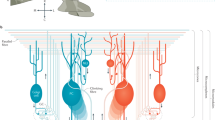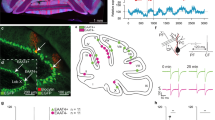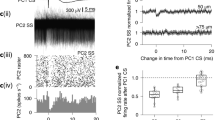Abstract
Long-term modification of transmission efficacy at synapses is the cellular basis of memory and learning1–4. A special type of synaptic plasticity in the cerebellum was postulated theoretically5,6, and has since been verified4,7–9. Each cerebellar Purkinje cell (PC) receives two distinct excitatory inputs, one from parallel fibres (PFs) and the other from a climbing fibre (CF). When these two types of inputs are conjunctively activated, PF–PC transmission undergoes long-term depression (LTD)4,7–9. Accumulated evidence suggests that LTD plays a role in the motor learning processes of the cerebellum10–12. At the molecular level, LTD appears to be caused by desensitization of receptor molecules in PC dendrites towards the PF neurotransmitter4, presumably L-glutamate (Glu) (ref. 12). Glu receptors are heterogeneous and can be divided into several subtypes13–15. In this study, we compared the potency of several Glu agonists in inducing LTD and found a highly selective dependency of LTD on the quisqualate(QA)-selective subtype of Glu receptors.
This is a preview of subscription content, access via your institution
Access options
Subscribe to this journal
Receive 51 print issues and online access
$199.00 per year
only $3.90 per issue
Buy this article
- Purchase on Springer Link
- Instant access to full article PDF
Prices may be subject to local taxes which are calculated during checkout
Similar content being viewed by others
References
Bliss, R. V. P. & Lømo, T. J. Physiol., Lond. 232, 331–356 (1973).
Kandel, E. R. & Schwartz, J. H. Science 218, 433–443 (1982).
Alcon, D. L. Science 226, 1037–1045 (1984).
Ito, M., Sakurai, M. & Tongroach, P. J. Physiol., Lond. 324, 113–134 (1982).
Marr, D. J. Physiol., Lond. 202, 437–470 (1969).
Albus, J. S. Math. Biosci. 10, 25–61 (1971).
Ito, M. & Kano, M. Neurosci. Lett. 33, 253–258 (1982).
Ekerot, C.-F. & Kano, M. Brain Res. 342, 357–360 (1985).
Sakurai, M. Neurosci. Lett. Suppl. 22, S26 (1985).
Ito, M. A. Rev. Neurosci. 5, 275–296 (1982).
Watanabe, E. Brain Res. 297, 169–174 (1984).
Ito, M. The Cerebellum and Neural Control, 81–83 (Raven, New York, 1984).
Watkins, J. C. & Evans, R. H. A. Rev. Pharmac. Tox. 21, 165–204 (1981).
McLennan, H. Prog. Neurobiol. 20, 251–271 (1983).
Foster, A. C. & Fagg, G. E. Brain Res. Rev. 7, 103–164 (1984).
Crepel, F., Dupont, J.-L. & Gardette, R. Brain Res. 279, 311–315 (1983).
Kimura, H., Okamoto, K. & Sakai, Y. J. Physiol., Lond. 365, 103–119 (1985).
Herndon, R. M. & Coyle, J. T. in Kainic Acid as a Tool in Neurobiology (eds McGeer, G., Olney, J. W. & McGeer, P. L.) 189–200 (Raven, New York, 1978).
Henke, H., Beaudet, A. & Cuénod, M. Brain Res. 219, 95–105 (1981).
Quinlan, J. E. & Davies, J. Neurosci. Lett. 60, 39–46 (1985).
Ekerot, C.-F. & Oscarsson, O. J. Physiol., Lond. 318, 207–221 (1981).
Llinàs, R. & Sugimori, M. J. Physiol., Lond. 305, 197–213 (1980).
Ishida, A. T. & Neyton, J. Proc. natn. Acad. Sci. U.S.A. 82, 1837–1841 (1985).
Author information
Authors and Affiliations
Rights and permissions
About this article
Cite this article
Kano, M., Kato, M. Quisqualate receptors are specifically involved in cerebellar synaptic plasticity. Nature 325, 276–279 (1987). https://doi.org/10.1038/325276a0
Received:
Accepted:
Issue Date:
DOI: https://doi.org/10.1038/325276a0
This article is cited by
-
Depressed by Learning—Heterogeneity of the Plasticity Rules at Parallel Fiber Synapses onto Purkinje Cells
The Cerebellum (2018)
-
Oscillations, Timing, Plasticity, and Learning in the Cerebellum
The Cerebellum (2016)
-
Inositol 1,4,5-Trisphosphate Receptor-Mediated Calcium Release in Purkinje Cells: From Molecular Mechanism to Behavior
The Cerebellum (2011)
Comments
By submitting a comment you agree to abide by our Terms and Community Guidelines. If you find something abusive or that does not comply with our terms or guidelines please flag it as inappropriate.



